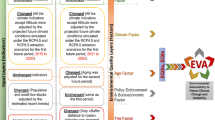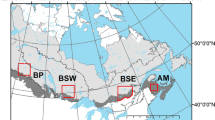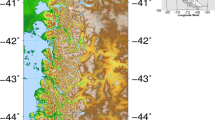Abstract
It is imperative to understand the climate change impact on the forest ecosystem to develop appropriate mitigation and management strategies. We have employed a process-based dynamic vegetation modeling (MAPSS-CENTURY: MC) approach to project change in vegetation life forms under projected climate conditions that attained 81% overall accuracy. The present and projected climate conditions suggested highly resilient/stable forest covers in wet climate regimes and moderately resilient in dry semi-arid regions. Several forested grids in the seasonally dry tropical forest in the Eastern Ghats and dry Deccan peninsula regions are estimated to be less resilient, which may experience a regime shift toward scrub and grassland. The future prediction demonstrated an upward temperature shift in the Western Himalayas and trans-Himalaya, which may facilitate forest spread at higher elevations. Although the forest cover resilience may increase in future climate conditions, the disturbances in several regions in the Deccan Peninsula and the Eastern Ghats may trigger forest to scrub and grassland transition. The inaccuracy in model simulation in the Western Himalayas could be attributed to coarse resolution grids (0.5°) failing to resolve the narrow climate niches. The spatially explicit model simulation provides opportunities to develop long-term climate change adaptation and conservation strategies.






Similar content being viewed by others
References
Allen, K., Dupuy, J. M., Gei, M. G., Hulshof, C., Medvigy, D., Pizano, C., Salgado-Negret, B., Smith, C. M., Trierweiler, A., van Bloem, S. J., Waring, B. G., Xu, X., & Powers, J. S. (2017). Will seasonally dry tropical forests be sensitive or resistant to future changes in rainfall regimes? Environmental Research Letters, 12(2). https://doi.org/10.1088/1748-9326/aa5968
Anjos, L. J. S., & de Toledo, P. M. (2018). Measuring resilience and assessing vulnerability of terrestrial ecosystems to climate change in South America. PLoS ONE, 13(3), 1–15. https://doi.org/10.1371/journal.pone.0194654
Bachelet, D. (2001). MC1, a dynamic vegetation model for estimating the distribution of vegetation and associated ecosystem fluxes of carbon, nutrients, and water: Technical documentation; in Cooperation with Oregon State University, Colorado State University (Vol. 508). US Department of Agriculture, Forest Service, Pacific Northwest Research Station.
Bachelet, D. (2015). History and general description of the dynamic global vegetation model MC1. Global Vegetation Dynamics: Concepts and Applications in the MC1 Model, 1–16.
Bachelet, D., Lenihan, J. M., Daly, C., & Neilson, R. P. (2000). Interactions between fire, grazing and climate change at Wind Cave National Park SD. Ecological Modelling, 134(2–3), 229–244.
Baker, W. L., & Williams, M. A. (2015). Bet-hedging dry-forest resilience to climate-change threats in the western USA based on historical forest structure. Frontiers in Ecology and Evolution, 2(JAN), 1–7. https://doi.org/10.3389/fevo.2014.00088
Behera, M. D., Murthy, M. S. R., Das, P., & Sharma, E. (2018). Modelling forest resilience in Hindu Kush Himalaya using geoinformation. Journal of Earth System Science, 127(7). https://doi.org/10.1007/s12040-018-1000-x
Chaturvedi, R. K., Gopalakrishnan, R., Jayaraman, M., Bala, G., Joshi, N. V., Sukumar, R., & Ravindranath, N. H. (2011a). Impact of climate change on Indian forests: A dynamic vegetation modeling approach. Mitigation and Adaptation Strategies for Global Change, 16(2), 119–142. https://doi.org/10.1007/s11027-010-9257-7
Chaturvedi, R. K., Gopalakrishnan, R., Jayaraman, M., Bala, G., Joshi, N. V., Sukumar, R., & Ravindranath, N. H. (2011b). Impact of climate change on Indian forests: A dynamic vegetation modeling approach. Mitigation and Adaptation Strategies for Global Change, 16(2), 119–142. https://doi.org/10.1007/s11027-010-9257-7
Chaturvedi, R. K., Tiwari, R., & Ravindranath, N. H. (2008). Climate change and forests in India. International Forestry Review, 10(2), 256–268.
Chitale, V. S., Behera, M. D., & Roy, P. S. (2014). Future of endemic flora of biodiversity hotspots in India. PLoS ONE, 9(12), e115264.
Cramer, W., Bondeau, A., Woodward, F. I., Prentice, I. C., Betts, R. A., Brovkin, V., Cox, P. M., Fisher, V., Foley, J. A., Friend, A. D., et al. (2001). Global response of terrestrial ecosystem structure and function to CO2 and climate change: Results from six dynamic global vegetation models. Global Change Biology, 7(4), 357–373.
Cristal, I., Ameztegui, A., González-Olabarria, J. R., & Garcia-Gonzalo, J. (2019). A decision support tool for assessing the impact of climate change on multiple ecosystem services. Forests, 10(5), 440.
Cronan, C. S. (2018). Biogeochemical models. In Ecosystem Biogeochemistry pp. 141–150. Springer.
Das, P., & Behera, M. D. (2019). Can the forest cover in India withstand large climate alterations? Biodiversity and Conservation, 28(8–9). https://doi.org/10.1007/s10531-019-01759-y
Das, P., Behera, M. D., & Roy, P. S. (2019). Estimation of forest cover resilience in India using MC2 DVM. International Geoscience and Remote Sensing Symposium (IGARSS). https://doi.org/10.1109/IGARSS.2019.8898739
Davidson, E. A., de Araújo, A. C., Artaxo, P., Balch, J. K., Brown, I. F., C. Bustamante, M. M., Coe, M. T., DeFries, R. S., Keller, M., Longo, M., Munger, J. W., Schroeder, W., Soares-Filho, B. S., Souza, C. M., & Wofsy, S. C. (2012). The Amazon basin in transition. Nature, 481(7381), 321–328. https://doi.org/10.1038/nature10717
Fang, O., Zhang, Q., & bin. (2019). Tree resilience to drought increases in the Tibetan Plateau. Global Change Biology, 25(1), 245–253. https://doi.org/10.1111/gcb.14470
Fernandez-Illescas, C. P., Porporato, A., Laio, F., & Rodriguez-Iturbe, I. (2001). The ecohydrological role of soil texture in a water-limited ecosystem. Water Resources Research, 37(12), 2863–2872.
Gonzalez, P., Neilson, R. P., Lenihan, J. M., & Drapek, R. J. (2010). Global patterns in the vulnerability of ecosystems to vegetation shifts due to climate change. Global Ecology and Biogeography, 19(6), 755–768.
Gouda, K. C., Nahak, S., & Goswami, P. (2018). Evaluation of a GCM in seasonal forecasting of extreme rainfall events over continental India. Weather and Climate Extremes, 21, 10–16.
Halofsky, J. E., Hemstrom, M. A., Conklin, D. R., Halofsky, J. S., Kerns, B. K., & Bachelet, D. (2013). Assessing potential climate change effects on vegetation using a linked model approach. Ecological Modelling, 266(1), 131–143. https://doi.org/10.1016/j.ecolmodel.2013.07.003
Kim, J. B., Kerns, B. K., Drapek, R. J., Pitts, G. S., & Halofsky, J. E. (2018). Simulating vegetation response to climate change in the Blue Mountains with MC2 dynamic global vegetation model. Climate Services, 10, 20–32.
Kim, J. B., Monier, E., Sohngen, B., Pitts, G. S., Drapek, R., McFarland, J., Ohrel, S., & Cole, J. (2017). Assessing climate change impacts, benefits of mitigation, and uncertainties on major global forest regions under multiple socioeconomic and emissions scenarios. Environmental Research Letters, 12(4), 45001.
Krishnan, R., Sanjay, J., Gnanaseelan, C., Mujumdar, M., Kulkarni, A., & Chakraborty, S. (2020). Assessment of climate change over the Indian region: a report of the ministry of earth sciences (MOES), government of India. Springer Nature.
Neilson, R. P. (1995). A model for predicting continental-scale vegetation distribution and water balance. Ecological Applications, 5(2), 362–385.
Noy-Meir, I. (1973). Desert ecosystems: Environment and producers. Annual Review of Ecology and Systematics, 4(1), 25–51.
Pachauri, R. K., Allen, M. R., Barros, V. R., Broome, J., Cramer, W., Christ, R., Church, J. A., Clarke, L., Dahe, Q., Dasgupta, P., & others. (2014). Climate change 2014: Synthesis report. Contribution of Working Groups I, II and III to the fifth assessment report of the Intergovernmental Panel on Climate Change. Ipcc.
Pulla, S., Ramaswami, G., Mondal, N., Chitra-Tarak, R., Suresh, H. S., Dattaraja, H. S., Vivek, P., Parthasarathy, N., Ramesh, B. R., & Sukumar, R. (2015). Assessing the resilience of global seasonally dry tropical forests. International Forestry Review, 17(2), 91–113. https://doi.org/10.1505/146554815815834796
Raju, K. Srinivasa, Sonali, P., & Kumar, D. Nagesh (2017). Ranking of CMIP5-based global climate models for India using compromise programming. Theoretical and Applied Climatology, 128(3), 563–574.
Ravindranath, N. H., Chaturvedi, R. K., Joshi, N., & v, Sukumar, R., & Sathaye, J. (2011a). Implications of climate change on mitigation potential estimates for forest sector in India. Mitigation and Adaptation Strategies for Global Change, 16(2), 211–227. https://doi.org/10.1007/s11027-010-9256-8
Ravindranath, N. H., Chaturvedi, R. K., Joshi, N., & v., Sukumar, R., & Sathaye, J. (2011b). Implications of climate change on mitigation potential estimates for forest sector in India. Mitigation and Adaptation Strategies for Global Change, 16(2), 211–227. https://doi.org/10.1007/s11027-010-9256-8
Ravindranath, N. H., Joshi, N. v., Sukumar, R., & Saxena, A. (2006). Impact of climate change on forests in India. Current Science, 354–361.
Ravindranath, N. H., & Sukumar, R. (1998). Climate change and tropical forests in India. In Climatic Change 39(2–3), 563–581. https://doi.org/10.1023/a:1005394505216
Ray, D., Behera, M. D., & Jacob, J. (2018). Evaluating ecological niche models: A comparison between Maxent and GARP for predicting distribution of Hevea brasiliensis in India. Proceedings of the National Academy of Sciences, India Section B: Biological Sciences, 88(4), 1337–1343.
Roy, P. S., Behera, M. D., Murthy, M. S. R., Roy, A., Singh, S., Kushwaha, S. P. S., Jha, C. S., Sudhakar, S., Joshi, P. K., Reddy, C. S., et al. (2015). New vegetation type map of India prepared using satellite remote sensing: Comparison with global vegetation maps and utilities. International Journal of Applied Earth Observation and Geoinformation, 39, 142–159.
Rubel, F., & Kottek, M. (2010). Observed and projected climate shifts 1901–2100 depicted by world maps of the Köppen-Geiger climate classification. Meteorologische Zeitschrift, 19(2), 135.
Sharma, A., & Goyal, M. K. (2018). Assessment of ecosystem resilience to hydroclimatic disturbances in India. Global Change Biology, 24(2), e432–e441. https://doi.org/10.1111/gcb.13874
Sharma, J., Upgupta, S., Jayaraman, M., Chaturvedi, R. K., Bala, G., & Ravindranath, N. H. (2017). Vulnerability of Forests in India: A National Scale Assessment. Environmental Management, 60(3), 544–553. https://doi.org/10.1007/s00267-017-0894-4
Sitch, S., Huntingford, C., Gedney, N., Levy, P. E., Lomas, M., Piao, S. L., Betts, R., Ciais, P., Cox, P., Friedlingstein, P., et al. (2008). Evaluation of the terrestrial carbon cycle, future plant geography and climate-carbon cycle feedbacks using five Dynamic Global Vegetation Models (DGVMs). Global Change Biology, 14(9), 2015–2039.
Staudinger, M. D., Grimm, N. B., Staudt, A., Carter, S. L., & Chapin, F. S. (2012). Impacts of climate change on biodiversity, ecosystems, and ecosystem services. United States Global Change Research Program.
Steinkamp, J., & Hickler, T. (2015). Is drought-induced forest dieback globally increasing? Journal of Ecology, 103(1), 31–43. https://doi.org/10.1111/1365-2745.12335
Tao, Z., & Jain, A. K. (2005). Modeling of global biogenic emissions for key indirect greenhouse gases and their response to atmospheric CO2 increases and changes in land cover and climate. Journal of Geophysical Research: Atmospheres, 110(D21).
Telwala, Y., Brook, B. W., Manish, K., & Pandit, M. K. (2013). Climate-induced elevational range shifts and increase in plant species richness in a Himalayan biodiversity epicentre. PLoS ONE, 8(2), e57103.
Verbesselt, J., Umlauf, N., Hirota, M., Holmgren, M., van Nes, E. H., Herold, M., Zeileis, A., & Scheffer, M. (2016). Remotely sensed resilience of tropical forests. Nature Climate Change, 6(11), 1028–1031.
Watterson, I. G., Bathols, J., & Heady, C. (2014). What influences the skill of climate models over the continents? Bulletin of the American Meteorological Society, 95(5), 689–700.
Ying, X. U., & Chong-Hai, X. U. (2012). Preliminary assessment of simulations of climate changes over China by CMIP5 multi-models. Atmospheric and Oceanic Science Letters, 5(6), 489–494.
Zhou, D., Hao, L., Kim, J. B., Liu, P., Pan, C., Liu, Y., & Sun, G. (2019). Potential impacts of climate change on vegetation dynamics and ecosystem function in a mountain watershed on the Qinghai-Tibet Plateau. Climatic Change, 156(1), 31–50.
Acknowledgements
This study has been carried out under the framework of “Climate Change Effects on Indian Forest Cover, a project under DST CoE in Climate Change.” The vegetation type map generated against a national-level “Biodiversity Characterization project” was utilized here, is thankfully acknowledged. The authors acknowledge the support provided by the authorities of the Indian Institute of Technology Kharagpur during this study.
Author information
Authors and Affiliations
Corresponding author
Ethics declarations
Conflict of interest
The authors declare no conflict of interest.
Additional information
Publisher's Note
Springer Nature remains neutral with regard to jurisdictional claims in published maps and institutional affiliations.
Supplementary Information
Below is the link to the electronic supplementary material.
10661_2022_10545_MOESM3_ESM.jpg
Supplementary file3 Predicted change in (i) precipitation, (ii) minimum and (iii) maximum temperature simulated by the CNRM-CM5 model (JPG 852 KB)
Rights and permissions
Springer Nature or its licensor holds exclusive rights to this article under a publishing agreement with the author(s) or other rightsholder(s); author self-archiving of the accepted manuscript version of this article is solely governed by the terms of such publishing agreement and applicable law.
About this article
Cite this article
Das, P., Behera, M.D., Bhaskaran, P.K. et al. Forest cover resilience to climate change over India using the MC2 dynamic vegetation model. Environ Monit Assess 194, 903 (2022). https://doi.org/10.1007/s10661-022-10545-3
Received:
Accepted:
Published:
DOI: https://doi.org/10.1007/s10661-022-10545-3




